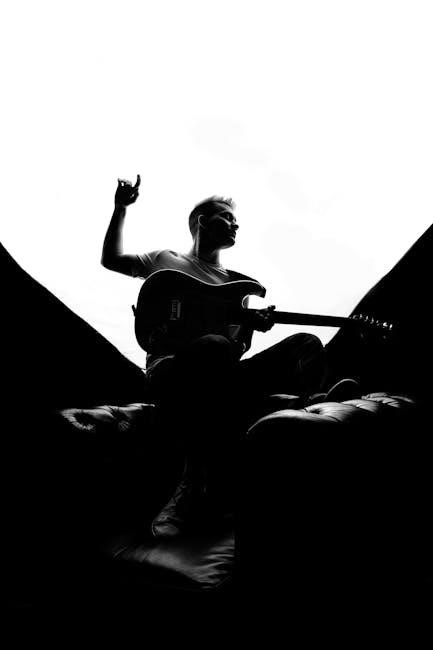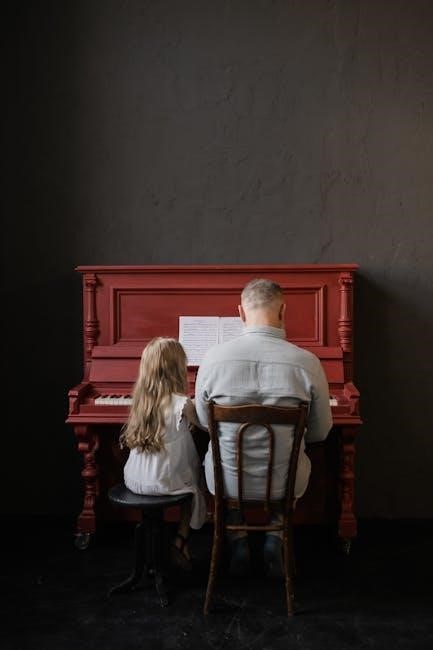Pachelbel’s Canon in D is a timeless Baroque composition, widely popular in weddings and ceremonies. Its sheet music is readily available in PDF format, offering arrangements for various instruments, from piano solos to string quartets, making it accessible for musicians of all skill levels. The piece’s enduring appeal lies in its elegant structure and harmonious chords, which have been transcribed and interpreted in countless ways, ensuring its relevance in modern music and education.
1.1 Historical Background of Pachelbel’s Canon in D
Johann Pachelbel, a German Baroque composer, created the Canon in D in the late 17th century. Originally written for three violins and basso continuo, it was part of a larger work called Canon and Gigue in D major. Despite its composition during the Baroque era, the piece gained widespread popularity in the 20th century, becoming a cultural phenomenon and a staple in weddings and ceremonies worldwide.
1.2 Importance of Sheet Music in Understanding the Composition
Sheet music is essential for analyzing Pachelbel’s Canon in D, offering a detailed visual representation of its structure, chords, and harmonies. It allows musicians to study the mathematical precision behind the composition and understand how the interweaving melodies create its iconic sound. Accessible in PDF format, the sheet music provides a universal tool for both performance and educational purposes, enabling deeper appreciation of the piece’s complexity and beauty.

The Structure and Composition of Canon in D
Pachelbel’s Canon in D features a mathematical structure with interweaving melodies and harmonies, creating a timeless appeal. Its chord progressions and layered composition captivate musicians and audiences alike, showcasing Baroque elegance and complexity in a deceptively simple framework.
2.1 The Mathematical Approach to Writing the Canon
Pachelbel’s Canon in D exemplifies a mathematical precision, with its structure based on repetitive chord progressions and a strict harmonic framework. The composition follows a logical sequence, where each voice enters with a delayed melody, creating a seamless interplay; This systematic approach, while rigid, results in a piece of profound beauty and balance, reflecting the composer’s mastery of Baroque counterpoint techniques. The predictable pattern allows for intricate variations, ensuring the piece remains both coherent and engaging.
2.2 The Role of Chords and Harmonies in the Piece
Pachelbel’s Canon in D is renowned for its iconic chord progressions and harmonies, which form the backbone of its timeless appeal. The piece is built on a repeating bass line and a series of harmonically rich chords, creating a lush, layered sound. The interplay of these elements generates a sense of forward motion, while the predictable harmonic structure provides stability, making it a masterpiece of Baroque counterpoint and a favorite for various instrumental arrangements.
Finding and Downloading Canon in D Sheet Music in PDF Format
Canon in D sheet music in PDF format is widely available online, with free and paid options across platforms like Musicnotes, IMSLP, and tocapartituras.org, catering to various instruments.
3.1 Popular Sources for Free and Paid Sheet Music
Popular sources for Canon in D sheet music include IMSLP, Musicnotes, and tocapartituras.org, offering free and paid PDF downloads. These platforms provide arrangements for various instruments, ensuring accessibility for musicians of all levels. They are reliable and widely used, making it easy to find the perfect version of Pachelbel’s Canon in D for personal or professional use.
3.2 Tips for Selecting the Right Arrangement for Your Needs
Consider your skill level, instrument, and performance context when choosing an arrangement. Check reviews and previews to ensure compatibility with your needs. Opt for formats like PDF for easy access and printing. Ensure the arrangement aligns with your musical style and technical proficiency, whether for personal practice, weddings, or professional performances. This helps in selecting the most suitable version of Canon in D.

Sheet Music Arrangements for Different Instruments
Canon in D sheet music is available for various instruments, including piano, guitar, violin, and string quartets; Each arrangement maintains the composition’s iconic harmony while adapting to the unique qualities of the instrument, ensuring a rich and authentic performance experience across diverse musical settings and skill levels.
4.1 Piano Solo and Duet Arrangements
Piano arrangements of Canon in D offer both solo and duet versions, allowing pianists to enjoy the piece individually or collaboratively. Solo arrangements capture the melody’s elegance, while duets enhance harmonic depth. These adaptations maintain Pachelbel’s original structure while providing a fresh, expressive interpretation suitable for various skill levels, from beginner to advanced pianists. The sheet music is widely available in PDF format, ensuring accessibility for all.
4.2 Guitar Tabs and Solo Versions
Guitar enthusiasts can explore Canon in D through tabs and solo arrangements, available in PDF and MIDI formats. These versions cater to both beginner and advanced players, offering a variety of interpretations. From classical guitar solos to modern adaptations, guitar tabs provide a versatile way to play this timeless piece. Many arrangements are free to download, making it accessible for musicians worldwide to enjoy and perform Pachelbel’s iconic composition.
The Role of Canon in D in Weddings and Ceremonies
Pachelbel’s Canon in D has become a wedding staple, its elegant melody evoking timeless romance. Its rise to ceremonial fame began with Prince Charles and Diana’s 1981 wedding, solidifying its place in matrimonial traditions due to its emotional and aesthetic appeal, making it a popular choice for couples worldwide seeking a classical ambiance.
5.1 How Canon in D Became a Wedding Staple
Pachelbel’s Canon in D gained wedding prominence after its 1981 use in Prince Charles and Diana’s ceremony. Its serene melody and emotional depth resonated universally, making it a timeless choice for couples. The piece’s versatility, with arrangements for various instruments, further cemented its popularity, transforming it into a classic wedding staple celebrated globally for its romantic and elegant ambiance.
5.2 Using Canon in D Sheet Music for Ceremonial Purposes
Canon in D’s emotional resonance and timeless beauty make it ideal for ceremonies. Its sheet music, available in PDF, offers versatile arrangements for piano, guitar, or strings, adapting to any setting. Often used as a prelude, processional, or recessional, the piece creates a serene atmosphere, making it a cherished choice for weddings and other memorable events, enhancing their emotional depth and elegance.

Transcription and Interpretation of the Canon
Pachelbel’s Canon in D has been transcribed for various instruments, with PDF sheet music offering interpretations for piano, guitar, and strings, showcasing its adaptability and timeless appeal.
6.1 Transcribing the Canon for Modern Instruments
Transcribing Pachelbel’s Canon for modern instruments involves adapting the baroque composition to suit contemporary ensembles. The piece is frequently arranged for piano, guitar, and strings, with PDF sheet music readily available. These transcriptions maintain the original’s harmonic richness while exploring new timbres and textures, ensuring its relevance in today’s musical landscape; The process often involves simplifying complex Baroque ornamentation for easier interpretation.
6.2 Interpretative Variations in Sheet Music Arrangements
Pachelbel’s Canon in D sheet music offers diverse interpretative variations, catering to different instruments and styles. Arrangements for piano, guitar, and strings are particularly popular, each maintaining the piece’s harmonic essence while introducing unique touches. Tempo, dynamics, and ornamentation vary across versions, allowing musicians to personalize the performance. These adaptations ensure the Canon remains fresh and accessible, bridging the gap between Baroque tradition and modern creativity.

Performance Tips for Canon in D
Mastering Canon in D requires precise tempo control and dynamic balance. Practice with sheet music to ensure structural clarity, and address technical challenges with focused rehearsals.
7.1 Mastering the Tempo and Dynamics
Accurately interpreting the tempo and dynamics of Canon in D is essential for a compelling performance. The piece is typically performed at a moderate tempo, often between 90-100 BPM, allowing the interweaving melodies to shine. Dynamics should be carefully controlled, with subtle variations to enhance the piece’s emotional depth. Musicians should focus on maintaining a steady rhythm while exploring expressive contrasts, ensuring a balanced and engaging rendition of this beloved composition.
7.2 Common Challenges and Solutions for Musicians
Musicians often face challenges with tempo consistency and harmonic balance in Canon in D. To overcome this, practicing with a metronome and simplifying complex sections can aid accuracy. Additionally, dynamics require careful attention to avoid overpowering individual parts. Emphasizing phrasing and articulation during rehearsals ensures a cohesive performance. Familiarity with the sheet music and collaborative practice can help musicians navigate these challenges effectively.

The Cultural and Historical Impact of Canon in D
Pachelbel’s Canon in D, a Baroque masterpiece, experienced a remarkable revival in popularity centuries after its composition. Its timeless appeal has made it a staple in weddings and modern culture, influencing countless adaptations and cementing its legacy as one of classical music’s most enduring pieces.
8.1 Pachelbel’s Legacy and Revival in Popular Culture
Johann Pachelbel’s Canon in D, once obscure, gained immense popularity in the 20th century. Its resurgence began in the 1960s and 1970s, with its adoption in weddings and films. By the 1980s, it became a cultural phenomenon, symbolizing celebration and romance. Today, its sheet music in PDF format is widely accessed, ensuring its continued relevance across generations and musical genres.
8.2 The Canon’s Influence on Contemporary Music
Pachelbel’s Canon in D has profoundly influenced contemporary music, inspiring countless adaptations and samples. Modern artists often incorporate its iconic chord progressions and harmonies, blending them with pop, rock, and electronic styles. Its timeless appeal continues to shape musical creativity, making it a foundational element in both classical and modern compositions, ensuring its relevance in today’s diverse musical landscape.
Resources for Learning and Playing Canon in D
Popular platforms like IMSLP and Musicnotes offer free and paid sheet music downloads. Educational guides and tutorials provide insights, helping musicians master the piece across various instruments.
9.1 Recommended Sheet Music Platforms and Websites
IMSLP, Musicnotes, and ToCapartituras are top platforms offering free and paid Canon in D sheet music. Hoffman Academy provides intermediate versions, while BrookWright Music features crafted arrangements. These sites cater to diverse skill levels, ensuring accessibility for pianists, guitarists, and ensembles. Their extensive libraries and user-friendly interfaces make them ideal for musicians seeking high-quality sheet music.
9.2 Communities and Forums for Sharing Arrangements
Online forums like Reddit’s r/WeAreTheMusicMakers and specialized music communities offer spaces for musicians to share and discover Canon in D arrangements. Platforms like IMSLP and Musicnotes host user-generated content, fostering collaboration. These communities enable artists to exchange ideas, post their versions, and gain feedback, enriching the musical landscape with diverse interpretations of Pachelbel’s iconic piece.

Legal and Copyright Considerations for Sheet Music
Pachelbel’s Canon in D is in the public domain, allowing free use and distribution. However, specific arrangements may be copyrighted, requiring proper licensing for public performances or commercial use.
10.1 Understanding Public Domain and Copyright Laws
Pachelbel’s Canon in D is in the public domain, meaning its original composition is free from copyright restrictions. However, specific arrangements or transcriptions may be copyrighted, requiring permission for use. Understanding these distinctions is crucial for legally using or distributing sheet music, ensuring compliance with copyright laws and respecting arrangers’ rights.
10.2 Licensing and Using Canon in D for Public Performances
While Pachelbel’s Canon in D is in the public domain, specific arrangements may require licensing for public performances. Ensure compliance by obtaining necessary permissions, especially for copyrighted versions. Platforms like Musicnotes or direct publisher contacts can provide licenses. Always verify legal requirements to avoid infringement, ensuring proper attribution and royalties where applicable.

User-Generated Content and Arrangements
Musicians and enthusiasts create unique arrangements of Canon in D, sharing them online. Collaborative projects and platforms foster creativity, allowing users to contribute and download diverse versions freely.
11;1 Sharing Your Own Canon in D Arrangements
Sharing your Canon in D arrangements fosters creativity and collaboration. Platforms like IMSLP and Hoffman Academy allow users to upload their unique interpretations, benefiting musicians globally. By sharing, you contribute to the piece’s evolution and gain feedback from enthusiasts. Ensure proper formatting and licensing to respect copyright laws, making your work accessible and inspiring others to create their own versions freely.
11.2 Collaborative Projects and Sheet Music Contributions
Collaborative projects breathe new life into Canon in D, fostering innovation and community engagement. Musicians worldwide share and adapt arrangements, creating diverse interpretations. Contributions to sheet music repositories like IMSLP ensure accessibility and inspire fresh creativity. These efforts not only preserve Pachelbel’s legacy but also encourage learning and performance, making the Canon a living, evolving piece of musical heritage for future generations to explore and enjoy.
The Future of Canon in D Sheet Music
Digital innovations are revolutionizing the distribution and preservation of Canon in D sheet music, ensuring its accessibility and timeless appeal for future generations of musicians and enthusiasts.
12.1 Digital Innovations in Sheet Music Distribution
Digital platforms now offer Canon in D sheet music in PDF and MIDI formats, enhancing accessibility. Innovations like interactive scores, mobile apps, and cloud storage simplify learning and performance. Subscription-based services and user-generated content platforms further democratize access, ensuring the piece remains relevant for future musicians. These tools cater to diverse skill levels, from beginners to professionals, fostering a vibrant musical community and preserving the composition’s legacy.
12.2 The Role of Technology in Preserving Classical Music
Technology plays a vital role in preserving classical music, with Canon in D being a prime example. Digital archiving ensures the piece’s longevity, while software tools enable precise transcriptions and interpretations. Online platforms and communities dedicated to sheet music distribution help maintain its cultural significance, allowing future generations to engage with and appreciate Pachelbel’s masterpiece in innovative and accessible ways, ensuring its timeless appeal endures.
Educational Resources for Canon in D
Sheet music PDFs and guides for Canon in D are widely available, offering learning tools for musicians and analysts to explore Pachelbel’s composition in depth.
13.1 Sheet Music for Beginners and Intermediate Players
Sheet music for Canon in D is available in simplified versions for beginners, focusing on melody and basic chords. Intermediate players can explore more complex arrangements, including piano solos and guitar tabs. Educational guides and tempo-controlled versions help learners master the piece gradually. These resources are designed to enhance understanding and performance skills, making Pachelbel’s composition accessible to musicians at various stages of their development.
13.2 Educational Guides for Analyzing the Canon
Educational guides for Canon in D provide in-depth analysis of its structure, chords, and harmonic progression. These resources, often included with sheet music, help musicians and students understand the mathematical precision behind Pachelbel’s composition. Guides typically include historical context, musical terminology explanations, and listening exercises, making the Canon accessible for educational purposes and fostering a deeper appreciation of its timeless appeal and complexity.

Canon in D Sheet Music for Ensembles and Orchestras
Canon in D sheet music is widely available for ensembles, including string quartets, chamber groups, and full orchestras. These arrangements maintain the piece’s elegant structure and harmonic richness, offering musicians a collaborative way to experience Pachelbel’s timeless composition. Whether for professional performances or educational purposes, ensemble versions provide a dynamic and engaging interpretation of the Canon.
14.1 Arrangements for String Quartets and Chamber Groups
Canon in D sheet music for string quartets and chamber groups is widely popular, offering intricate arrangements that preserve Pachelbel’s original elegance. These versions often feature lush harmonies and layered melodies, ideal for both professional ensembles and amateur groups. Many arrangements are available in PDF format, catering to various skill levels and performance settings, ensuring the piece’s timeless beauty resonates in intimate or grand musical contexts.
14.2 Full Orchestra Versions of the Canon
Full orchestra versions of Canon in D expand the piece’s grandeur, utilizing a wide range of instruments to enhance dynamics and textures. These arrangements maintain Pachelbel’s original elegance while adding depth and complexity, making them ideal for large-scale performances. The emotional resonance is amplified, and the layered harmonies create a captivating experience. Many full orchestra versions are available as downloadable PDFs, perfect for conductors and musicians seeking to bring this classic to life on a grand scale.

The Emotional and Aesthetic Appeal of Canon in D
Canon in D’s timeless melody and harmonious structure evoke universal emotions, creating a serene yet powerful experience. Its aesthetic beauty transcends time, resonating deeply with listeners worldwide.
15.1 The Timeless Beauty of the Canon’s Melody
The Canon’s melody captivates with its simplicity and elegance, blending Baroque sophistication with emotional depth. Its serene, flowing phrases create a sense of balance and harmony, making it universally cherished. The interplay of ascending and descending motifs contributes to its enduring appeal, ensuring its place in both classical and contemporary musical landscapes. Its beauty remains untouched by time, resonating across generations and cultures alike, making it a cornerstone of classical music.
15.2 The Emotional Impact of the Music in Modern Contexts
Pachelbel’s Canon in D evokes profound emotions, transcending time and cultural boundaries. Its serene melody is often used in weddings, ceremonies, and reflective moments, creating a sense of joy and tranquility. In modern media, it frequently accompanies heartfelt scenes, amplifying emotional depth. Its universal appeal lies in its ability to connect with listeners on a deeply personal level, making it a timeless choice for expressing emotion in various contexts, from intimate gatherings to grand celebrations.
Pachelbel’s Canon in D resonates deeply in modern times, evoking joy and tranquility. Its serene melody is often used in weddings, ceremonies, and media, creating emotional connections. The piece’s timeless beauty enhances heartfelt moments, making it a universal choice for expressing emotion in contemporary settings, from intimate gatherings to grand celebrations, ensuring its enduring relevance and appeal.
16.1 The Enduring Popularity of Canon in D
Pachelbel’s Canon in D remains universally beloved due to its elegant simplicity and emotional depth. Its widespread use in weddings, ceremonies, and media underscores its timeless appeal. The piece’s mathematical structure, harmonious chords, and serene melody create a lasting impression. Its versatility across instruments and arrangements ensures its relevance, making it a cherished choice for both musicians and audiences, spanning generations and cultural boundaries effortlessly.
16.2 The Significance of Sheet Music in Preserving the Piece
Sheet music plays a vital role in preserving Pachelbel’s Canon in D, ensuring its accurate transmission across generations. It provides a detailed blueprint for musicians, maintaining the composer’s intent and intricate harmonies. With widespread availability in PDF and other formats, it enables performances and interpretations, fostering cultural and educational preservation of this Baroque masterpiece, ensuring its legacy endures for future musicians and audiences alike.
